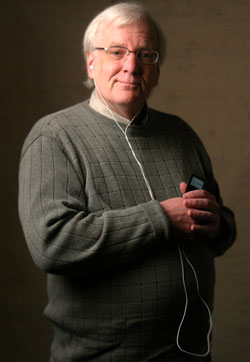The Olin School of Business has long known that business is an art. Now the school is demonstrating that link visually.
Through high-end photography now hanging in the hallways, the school is highlighting its professors and their research. It may sound mundane, but as Jan Broderick, the Olin School’s visual program consultant and one of the organizers of the exhibit, said, “It’s not your typical portrait style.”

The school wanted a way to celebrate the professors’ work in a way that is uniquely “Olin,” said Broderick’s co-organizer, Deborah Booker, associate dean and director of external relations at the business school.
“The photographs portray our faculty in distinctive ways on several levels,” Booker said. “We wanted to create artwork that drew people to portraits for their distinctiveness as faculty, as human beings and as researchers.”
Framed in quartersawn oak, the photographs are printed on watercolor paper, which softens the edges of images — in the same way that old movies filmed starlets through a layer of gauze.
A brief summary of the professors’ latest research is underneath their image. The entire layout seems to float inside its frame.
The setting, however, is only one part of the effect. What really makes the pictures stand out is their content.
“Our goal was to have the professors in very natural poses that reflect each faculty member’s individuality, while the description of their work reflects their intellectuality,” Broderick said. “Basically, we told them they could wear whatever they wanted to. They knew they were going to get their picture taken, but that was about it.”
Tat Chan, Ph.D., assistant professor of marketing, showed up wearing blue jeans, a brown shirt and a black windbreaker. Chan is very tall and thin, Broderick and Booker noted. Upon seeing him, they immediately thought: warrior.
His photograph shows him standing slightly sideways, hands disappearing into his jacket and the slightest smile on his face.
“We got this very striking, very stark picture of him because of his dark clothes and dark hair and he has very good bone structure,” Broderick said. “It really captured a very individual look.”
“Students have commented that they don’t know who Tat Chan is, but he looks like a very interesting person,” said Glenn MacDonald, Ph.D., senior associate dean and the John M. Olin Distinguished Professor of Economics and Strategy. “Typically, their next thought is, ‘What does he teach?'”
MacDonald was the instigator for having a display for professors and their research, but he didn’t want anything generic. He wanted something that would jump out at anyone who walked into Simon Hall; something that captured the school’s character.
“We’re fundamentally a high-end research institution,” MacDonald said. “I think of us as very imaginative, innovative, creative and deep.
“If we continue to invest in this artwork and expand its presence, just think of the impact it could have on prospective students, employers and alumni. They might walk into the school and say, ‘This place is both gorgeous and intriguing.'”
Details of how frequently the photographs will change are still being worked out. For the next few months, people can see Chan’s image in the Simon Hall foyer highlighting his work on understanding consumer choices for soft drinks; Raymond T. Sparrowe, Ph.D., the Marcile and James Reid Professor and associate professor of organizational behavior, and his research in leadership tactics that affect workers’ behavior; and Tava Olsen, Ph.D., associate professor of operations and manufacturing management, and her studies on the setup time and costs for a multipurpose manufacturing machine.
Mahendra R. Gupta, Ph.D., dean of the Olin School and the Geraldine J. and Robert L. Virgil Professor in Accounting and Management, enjoys seeing the faculty and their research recognized in such an unusual manner.
“We have a strong group of research faculty at Olin,” Gupta said. “They’e recognized internationally for their expertise and innovative research.
“We want to celebrate them in our own building. We will continue to find new ways to applaud research success of our faculty.”